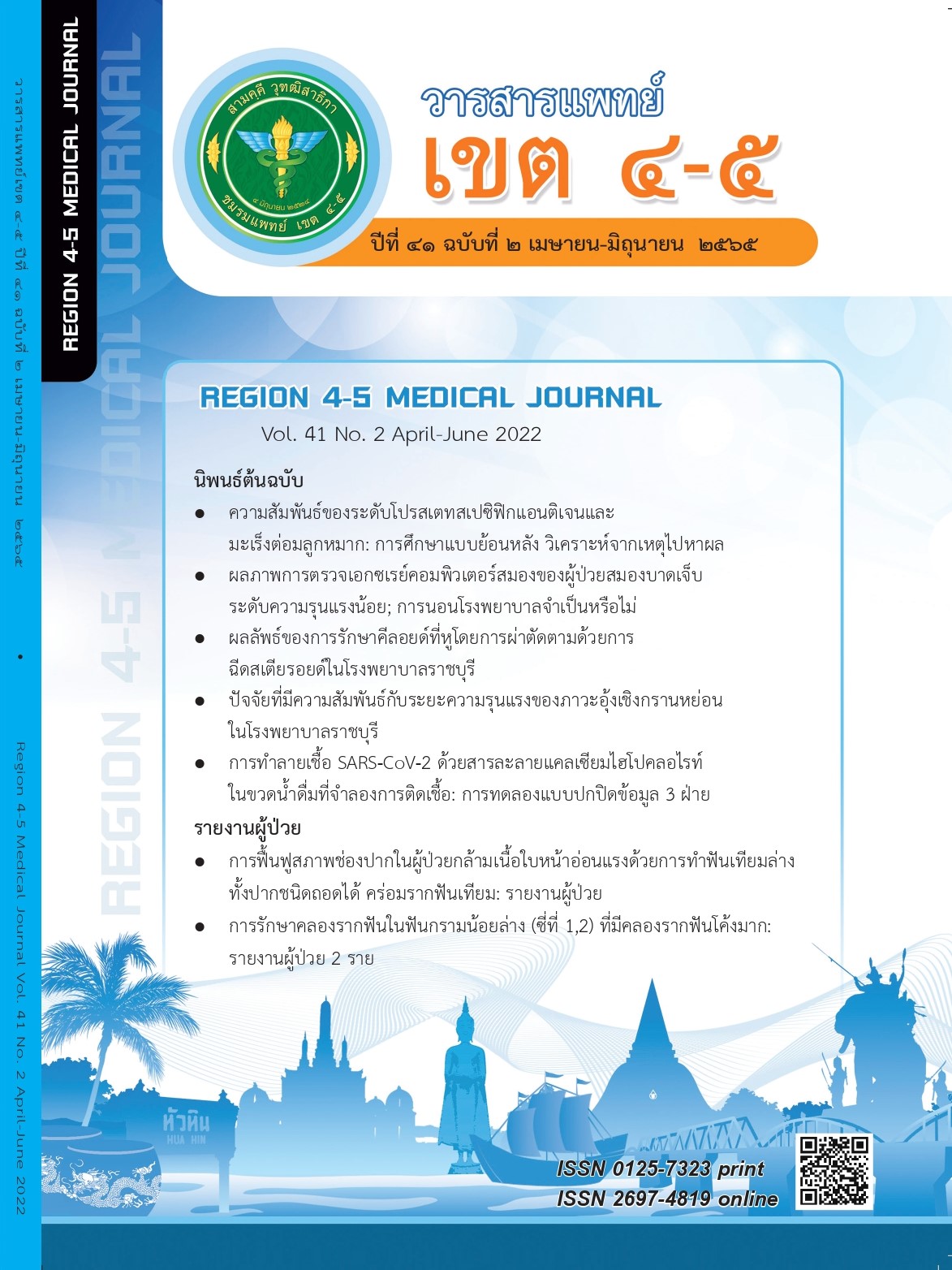ผลลัพธ์ของการรักษาคีลอยด์ที่หูโดยการผ่าตัดตามด้วยการฉีดสเตียรอยด์ในโรงพยาบาลราชบุรี
คำสำคัญ:
คีลอยด์ที่หู, การผ่าตัดคีลอยด์, การฉีดสเตียรอยด์เข้าที่คีลอยด์บทคัดย่อ
วัตถุประสงค์: เพื่อศึกษาประสิทธิภาพและอัตราการเกิดซ้ำ (recurrent rate) ของการรักษาคีลอยด์ที่หูโดยการผ่าตัดตามด้วยการฉีดสเตียรอยด์
วิธีการศึกษา: การศึกษาเชิงพรรณนาย้อนหลัง (retrospective descriptive study) รวบรวมผู้ป่วยทั้งหมดที่ได้รับการรักษาคีลอยด์ที่หู ที่ผ่านการผ่าตัดคีลอยด์และตามด้วยการฉีดสเตียรอยด์ (triamcinolone acetonide 40mg/ml) ในช่วงวันที่ 1 มิถุนายน พ.ศ. 2562 ถึงวันที่ 30 มิถุนายน พ.ศ. 2564 เก็บข้อมูลเพศ อายุ ตำแหน่งการเกิดคีลอยด์ จำนวนคีลอยด์ สาเหตุของการเกิดคีลอยด์ ลักษณะของคีลอยด์ ความแข็ง ความแดง ความนูน อาการคันและเจ็บจากคีลอยด์ จำนวนครั้งในการฉีดยาสเตียรอยด์หลังผ่าตัด ความห่างของระยะเวลาในการฉีดแต่ละเข็ม ระยะเวลาตรวจติดตามทั้งหมด และภาวะแทรกซ้อนหลังผ่าตัด
ผลการศึกษา: ผู้ป่วยทั้งหมด 13 คน เป็นเพศหญิงทั้งหมด อายุเฉลี่ย 24.8 (18–60 ปี) มีรอยโรคคีลอยด์ทั้งหมด 18 รอยโรค ระยะเวลาตรวจติดตามหลังผ่าตัดโดยเฉลี่ยที่ 14 เดือน (6–24 เดือน) จำนวนครั้งในการฉีด สเตียรอยด์หลังผ่าตัด 3–6 ครั้ง โดยค่าเฉลี่ยที่ 4 ครั้ง ห่างกันทุก 4–8 สัปดาห์ พบว่าไม่มีรอยโรคคีลอยด์เกิดซ้ำในบริเวณที่ได้รับการผ่าตัดตามด้วยการฉีดยาสเตียรอยด์ (ร้อยละ 0) ค่ามัธยฐานของคะแนนเกียวโตสการ์ก่อนผ่าตัดคือ 7 (6–8) และลดลงมาเป็นค่ามัธยฐานหลังผ่าตัดตามด้วยการฉีดสเตียรอยด์ที่ 1 (0–2) โดยแตกต่างอย่างมีนัยสำคัญและไม่มีผู้ป่วยรายใดเกิดภาวะแทรกซ้อนหลังผ่าตัด
สรุป: การผ่าตัดรักษาคีลอยด์ที่หูตามด้วยการฉีดยาสเตียรอยด์เข้าที่รอยโรคได้ผลการักษาที่ดี เป็นการผ่าตัดใช้ยาชาเฉพาะที่และการใช้ยาสเตียรอยด์ฉีดที่หาได้ง่ายและราคาไม่แพงในโรงพยาบาลทั่วไป อย่างไรก็ตามการศึกษานี้ยังมีข้อจำกัดในรูปแบบการศึกษาที่ไม่มีกลุ่มเปรียบเทียบ ระยะเวลาการตรวจติดตามผู้ป่วยที่สั้น และจำนวนประชากรที่ศึกษามีปริมาณน้อย ควรมีการศึกษาเพิ่มเติมในจำนวนประชากรที่มากขึ้นและระยะเวลาการตรวจติดตามที่ยาวนานกว่านี้ต่อไป
เอกสารอ้างอิง
Al-Attar A, Mess S, Thomassen JM, et al. Keloid pathogenesis and treatment. Plast Reconstr Surg. 2006;117(1):286–300.
Niessen FB, Spauwen PH, Schalkwijk J, et al. On the nature of hypertrophic scars and keloids: a review. Plast Reconstr Surg. 1999;104(5):1435–58.
Ketchum LD. Hypertrophic scars and keloids. Clinics in plastic surgery. 1977;4(2):301–10.
Jones ME, Hardy C, Ridgway J. Keloid Management: A Retrospective Case Review on a New Approach Using Surgical Excision, Platelet-Rich Plasma, and In-office Superficial Photon X-ray Radiation Therapy. Adv Skin Wound care. 2016;29(7):303–7.
Sidle DM, Kim H. Keloids: prevention and management. Facial plast surg clin North Am. 2011;19(3):505–15.
Klumpar DI, Murray JC, Anscher M. Keloids treated with excision followed by radiation therapy. J Am Acad Dermatol. 1994;31(2 Pt 1):225–31.
Shin JY, Lee JW, Roh SG, et al. A Comparison of the Effectiveness of Triamcinolone and Radiation Therapy for Ear Keloids after Surgical Excision: A Systematic Review and Meta-Analysis. Plast Reconstr Surgery. 2016;137(6):1718–25.
Uppal RS, Khan U, Kakar S, et al. The effects of a single dose of 5-fluorouracil on keloid scars: a clinical trial of timed wound irrigation after extralesional excision. Plast Reconstr Surg. 2001;108(5):1218–24.
Davison SP, Mess S, Kauffman LC, et al. Ineffective treatment of keloids with interferon alpha-2b. Plast Reconstr Surg. 2006;117(1):247–52.
Bran GM, Brom J, Hörmann K, et al. Auricular keloids: combined therapy with a new pressure device. Arch Facial Plast Surg. 2012;14(1):20–6.
Yamawaki S, Naitoh M, Ishiko T, et al. Keloids can be forced into remission with surgical excision and radiation, followed by adjuvant therapy. Ann Plast Surg. 2011;67(4):402–6.
Lee HJ, Jang YJ. Recent Understandings of Biology, Prophylaxis and Treatment Strategies for Hypertrophic Scars and Keloids. Int J Mol Sci. 2018;19(3).
Naitoh M, Hosokawa N, Kubota H, et al. Upregulation of HSP47 and collagen type III in the dermal fibrotic disease, keloid. Biochem Biophys Res commun. 2001;280(5):1316–22.
Berman B, Maderal A, Raphael B. Keloids and Hypertrophic Scars: Pathophysiology, Classification, and Treatment. Dermatol Surg. 2017;43 Suppl 1:S3–S18.
Ogawa R. The most current algorithms for the treatment and prevention of hypertrophic scars and keloids. Plast Reconstr Surg. 2010;125(2):557–68.
Leventhal D, Furr M, Reiter D. Treatment of keloids and hypertrophic scars: a meta-analysis and review of the literature. Arch Facial Plast Surg. 2006;8(6):362–8.
Levy DS, Salter MM, Roth RE. Postoperative irradiation in the prevention of keloids. AJR Am J Roentgenol. 1976;127(3):509–10.
Ogawa R, Yoshitatsu S, Yoshida K, et al. Is radiation therapy for keloids acceptable? The risk of radiation-induced carcinogenesis. Plast Reconstr Surg. 2009;124(4):1196–1201.
Jung JY, Roh MR, Kwon YS, et al. Surgery and perioperative intralesional corticosteroid injection for treating earlobe keloids: a korean experience. Ann Dermatol. 2009;21(3):221–5.
Mohammadi AA, Kardeh S, Motazedian GR, et al. Management of Ear Keloids Using Surgical Excision Combined with Postoperative Steroid Injections. World J Plast Surg. 2019;8(3):338–44.
ดาวน์โหลด
เผยแพร่แล้ว
รูปแบบการอ้างอิง
ฉบับ
ประเภทบทความ
สัญญาอนุญาต

อนุญาตภายใต้เงื่อนไข Creative Commons Attribution-NonCommercial-NoDerivatives 4.0 International License.
ลิขสิทธิ์บทความเป็นของผู้เขียนบทความ แต่หากผลงานของท่านได้รับการพิจารณาตีพิมพ์ลงวารสารแพทย์เขต 4-5 จะคงไว้ซึ่งสิทธิ์ในการตีพิมพ์ครั้งแรกด้วยเหตุที่บทความจะปรากฎในวารสารที่เข้าถึงได้ จึงอนุญาตให้นำบทความในวารสารไปใช้ประโยชน์ได้ในเชิงวิชาการโดยจำเป็นต้องมีการอ้างอิงถึงชื่อวารสารอย่างถูกต้อง แต่ไม่อนุญาตให้นำไปใช้ในเชิงพาณิชย์




